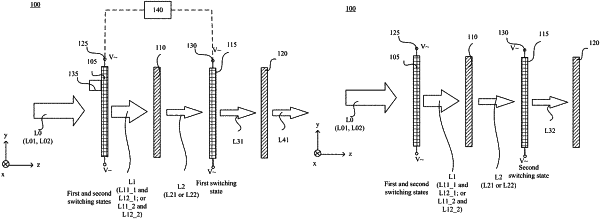| CPC G02F 1/0311 (2013.01) [G02F 1/133528 (2013.01); G02F 1/3515 (2013.01); G02F 1/133638 (2021.01); G02F 1/134381 (2021.01)] | 20 Claims |

|
1. A device, comprising:
a polarization rotator configured to be switchable between operating in two switching states;
a controller configured to control the polarization rotator to switch between operating in the two switching states at a predetermined switching frequency, to thereby switch, a polarization of a component of an input light having an initial light intensity, between two orthogonal polarizations at the predetermined switching frequency; and
a polarizer coupled with the polarization rotator, and configured to convert the input light transmitted through the polarization rotator into an output light having a light intensity reduced to a predetermined percentage of the initial light intensity of the input light.
|
|
14. A method, comprising:
switching, by a polarization rotator, a polarization of a component of an input light having an initial light intensity, between two orthogonal polarizations; and
converting, by a polarizer coupled with the polarization rotator, the input light output from the polarization rotator into an output light having a light intensity reduced to a predetermined percentage of the initial light intensity of the input light,
wherein the predetermined percentage is substantially the same when the input light has different initial polarizations.
|
|
18. A method, comprising:
controlling, by a controller, a polarization rotator to switch between operating in a first switching state and a second switching state at a predetermined switching frequency, to thereby switch, a polarization of a component of an input light having an initial light intensity, between two orthogonal polarizations at the predetermined switching frequency; and
converting, by a polarizer coupled with the polarization rotator, the input light output from the polarization rotator into an output light having a light intensity reduced to a predetermined percentage of the initial light intensity of the input light.
|